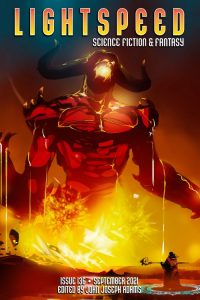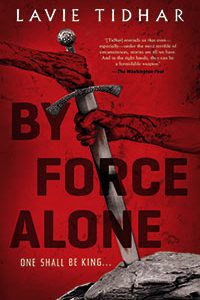Gary K. Wolfe Reviews A Brightness Long Ago by Guy Gavriel Kay
 A Brightness Long Ago, Guy Gavriel Kay (Berkley 978-0-451-47298-4, $27.00, 448pp, hc) May 2019.
A Brightness Long Ago, Guy Gavriel Kay (Berkley 978-0-451-47298-4, $27.00, 448pp, hc) May 2019.
At the risk of oversimplification – well, no, to be honest, with the intent of oversimplification – the fantastic genres have a long and complex relationship with historical fiction, but they often tend to use it to provide templates for their own preoccupations. Horror seems to love the Middle Ages, with its demons and tortures and general misery; fantasy seems attracted to the Renaissance’s labyrinthine court intrigues and great clothes; and SF likes the Enlightenment because of – well, enlightenment. What sometimes gets lost behind the set design, though, is the awareness that our common notions of time, nature, and causation weren’t necessarily shared by the folks who actually had to live in these worlds. When skittering, shrieking demons show up on the very first page of Jo Walton’s Lent, or an ambiguous ghost makes an appearance late in Guy Gavriel Kay’s A Brightness Long Ago, it’s easy to read these as supernatural intrusions in a world otherwise not unlike our own, until you pause to think that, for the characters involved, the line between natural and supernatural was problematical at best. As one of Kay’s characters muses about the ghost, “The world was not to be understood in simple ways, however one might wish to make that so.”
Kay, of course, is a master at reminding us that past worldviews were as different from ours as past worlds. His latest novel, as elegantly polyphonic as ever, returns us to his analog of 15th-century Italy, here called Batiara, that we last saw in Children of Earth and Sky, set almost a thousand years after his Saratine Mosaic novels, in the same general region, and about 25 years after the fall of Sarantium. The main action of A Brightness Long Ago begins a few years before that signature event, but the main narrative viewpoint is many years later, as the aging councilor Guidanio Cerra, called Danio, recalls the events of his youth when, the son of a lowly tailor, he was admitted to a celebrated school on what amounts to a scholarship program for gifted poorer students. Despite his plans to go into business as a simple bookseller (which he eventually manages), this brings him to the attention of the chief steward of a monstrous and thoroughly disgusting count nicknamed “the Beast,” which in turn draws him into the circle of Adria Ripoli, a fiercely independent-minded duke’s daughter (Kay’s female characters are never without agency, but the two major women here are among his most impressive). Danio realizes that Adria secretly plans to assassinate the Beast (don’t mutter “spoiler”; we’re not even halfway through chapter one), and his decisions to remain silent and later to help her escape after she is wounded, radically alter the course of both their lives.
Kay then shifts the point of view away from Danio’s memories and introduces us to the healer Jelena, whose sensitivities to things not seen make her not only the novel’s main conduit to those “supernatural” manifestations mentioned above, but also one of the connecting threads in the various stories that unfold later (it’s probably no accident that Kay termed one of his series a tapestry and another a mosaic; this one’s a tapestry). The central political conflict that emerges involves Adria’s uncle Folco d’Acorsi and his rival mercenary leader Teobaldo di Remigio – whose mistress Ginevra is a third powerful female figure. While this rivalry sets up the central historical dynamic, and serves as a reminder of the extent to which armies-for-hire shaped the politics of the age, and while there are some impressive battle pageants and sieges of the sort Kay writes with extraordinary clarity, two of the most exciting scenes involve horse races, of all things, one involving Danio and the other Adria. These serve as reminders that actions taken by characters on the periphery of power, sometimes as the result of almost random decisions, can shift the vectors of history as decisively as the highly public campaigns of the powerful. When the death of a major figure comes to haunt the second half of the novel in a way that’s as emotionally devastating for us as for the other characters, it also seems nearly random in its abruptness and absurdity.
While Kay occasionally shifts into various character viewpoints other than the memories of Danio, there is yet another narrative voice, almost invisible for most of the tale, who introduces us to the aging Danio at the very beginning and then effectively disappears until more than halfway through, with a remarkable passage reminding us that “Someone made this, made choices doing so.” “Don’t we all know that stories can be sparks leaping from the bonfire of an offered tale to become their own fire, if they land on the right ground, if kindling is there and a light breeze but not a hard wind?” Maybe it was that “light breeze,” but this mysterious voice reminded me of nothing so much as Conrad’s “Heart of Darkness”, when we realized that we’re not directly hearing Marlow’s tale, but the account of a seaman listening to Marlow. By calling our attention to the dance between randomness – those bonfire sparks – and design, Kay seems almost to be calling attention to his own aesthetic. It’s easy to read A Brightness Long Ago as an extended parable of butterfly effects and unforetold consequences, but this reminder that Kay’s novels are among the most elegantly designed in modern fiction goes a lot farther toward explaining the effects of his unique approach of placing very real people in not-quite-imaginary gardens. Stories, he reminds us, are told, but novels are shaped. A Brightness Long Ago – a title that can refer both to Danio’s memories and the echoes of our own history – is not only the latest example of how Kay has honed this technique over decades; it’s also one of the best.
Gary K. Wolfe is Emeritus Professor of Humanities at Roosevelt University and a reviewer for Locus magazine since 1991. His reviews have been collected in Soundings (BSFA Award 2006; Hugo nominee), Bearings (Hugo nominee 2011), and Sightings (2011), and his Evaporating Genres: Essays on Fantastic Literature (Wesleyan) received the Locus Award in 2012. Earlier books include The Known and the Unknown: The Iconography of Science Fiction (Eaton Award, 1981), Harlan Ellison: The Edge of Forever (with Ellen Weil, 2002), and David Lindsay (1982). For the Library of America, he edited American Science Fiction: Nine Classic Novels of the 1950s in 2012, with a similar set for the 1960s forthcoming. He has received the Pilgrim Award from the Science Fiction Research Association, the Distinguished Scholarship Award from the International Association for the Fantastic in the Arts, and a Special World Fantasy Award for criticism. His 24-lecture series How Great Science Fiction Works appeared from The Great Courses in 2016. He has received six Hugo nominations, two for his reviews collections and four for The Coode Street Podcast, which he has co-hosted with Jonathan Strahan for more than 300 episodes. He lives in Chicago.
This review and more like it in the May 2019 issue of Locus.
 While you are here, please take a moment to support Locus with a one-time or recurring donation. We rely on reader donations to keep the magazine and site going, and would like to keep the site paywall free, but WE NEED YOUR FINANCIAL SUPPORT to continue quality coverage of the science fiction and fantasy field.
While you are here, please take a moment to support Locus with a one-time or recurring donation. We rely on reader donations to keep the magazine and site going, and would like to keep the site paywall free, but WE NEED YOUR FINANCIAL SUPPORT to continue quality coverage of the science fiction and fantasy field.








